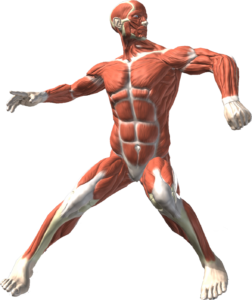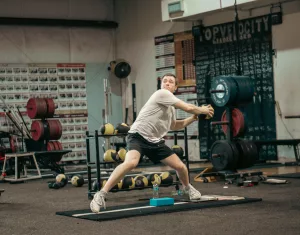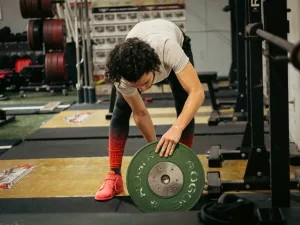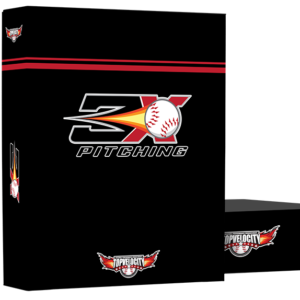These key factors affect the velocity of a throw; biomechanics, intensity, and athleticism.
In the world of sports, being able to throw an object quickly and precisely is a crucial skill for athletes in all sports. The throw's velocity, a key component of an athlete's performance, is influenced by a complex web of variables. This article explores the crucial elements—biomechanics, intensity, and athleticism—that influence the velocity of a throw. A thorough comprehension of these elements can help athletes and coaches create specialized training plans and methods to improve performance on the field.
Intensity is the amount of effort put forth during a throw, and biomechanics is the science that studies how the human body functions and moves during physical activity. Contrarily, athleticism includes all of a person's physical prowess, including strength, agility, and coordination. These elements work together to determine the velocity of a throw, and changes in any one of them can have a big impact on the results. This article aims to provide a detailed exploration of these factors, elucidating the complex relationship between the body's mechanics, an athlete's effort, and their innate physical abilities in achieving high-velocity throws.
Here is some key points covered in this article on what factors affect the velocity of a throw:
- Throwing velocity is influenced by biomechanics, intensity, and athleticism, with each factor playing a crucial role in an athlete's performance.
- The 3X Pitching Velocity Program and 2X Velocity Program are designed for pitchers and position players, respectively, to improve their throwing mechanics and leverage kinetic chains.
- Biomechanics focuses on the role of kinetic chains and optimal technique, ensuring efficient energy transfer throughout the body during the throwing motion.
- Intensity involves power generation and efficient energy transfer, which starts with the lower body and hips, and progresses through the core and upper body.
- Athleticism encompasses strength, coordination, and flexibility, all of which contribute to peak performance and injury prevention.
- Athletes can achieve higher throwing velocities by participating in the 3X Pitching Velocity Program or the 2X Velocity Program, which focus on enhancing biomechanics, intensity, and athleticism to optimize performance.
Biomechanics: The Role of Kinetic Chain and Optimal Technique
 Athletes who want to increase their throwing velocity must comprehend the biomechanics of throwing. To carry out complex movements like throwing, the human body uses a group of linked bones and joints referred to as kinetic chains. This coordinated sequence of movements transfers energy from larger, more powerful muscles to smaller ones, ultimately resulting in the acceleration of an object. To optimize throwing velocity, athletes must fine-tune their technique to leverage these kinetic chains effectively.
Athletes who want to increase their throwing velocity must comprehend the biomechanics of throwing. To carry out complex movements like throwing, the human body uses a group of linked bones and joints referred to as kinetic chains. This coordinated sequence of movements transfers energy from larger, more powerful muscles to smaller ones, ultimately resulting in the acceleration of an object. To optimize throwing velocity, athletes must fine-tune their technique to leverage these kinetic chains effectively.
For pitchers specifically, the 3X Pitching Velocity Program focuses on improving the biomechanics of their throwing motion. This all-encompassing program seeks to hone an athlete's pitching mechanics while also enhancing their functional strength, power, and flexibility. The 3X Pitching Velocity Program helps athletes realize their potential for high-velocity throws by emphasizing proper sequencing and effective energy transfer throughout the kinetic chain. The program also includes video analysis, allowing pitchers to visualize and perfect their technique for peak performance.
The 2X Velocity Program provides a comparable method for increasing throwing velocity for position players. This program is specifically designed to meet the demands of position players, taking into account the wide variety of movements and throwing techniques necessary for their roles. The 2X Velocity Program places a strong emphasis on the value of good body mechanics, effective energy transfer, and the development of functional strength to improve throwing performance. The program gives athletes the tools to improve their technique and make the most of their kinetic chains through a combination of specialized drills, strength training, and video analysis.
The importance of biomechanics in achieving high-velocity throws is highlighted by both the 3X Pitching Velocity Program and the 2X Velocity Program. Athletes can unlock their potential for better performance on the field by mastering the function of kinetic chains and honing their technique. These specialized programs give athletes the necessary framework and direction to comprehend and improve their biomechanics, which increases throwing velocity and contributes to overall success in their respective disciplines.
Intensity: Power Generation and Efficient Energy Transfer
 Another important element that affects a throw's velocity is its intensity. Intensity encapsulates the effort and force generated by an athlete to propel an object, such as a baseball or a football, through the air. To achieve greater throwing velocity, athletes must focus on generating power and transferring energy efficiently throughout their kinetic chain. Before moving on to the smaller, more agile muscles in the upper body and arm, this process begins with the larger, more powerful muscles in the lower body and core.
Another important element that affects a throw's velocity is its intensity. Intensity encapsulates the effort and force generated by an athlete to propel an object, such as a baseball or a football, through the air. To achieve greater throwing velocity, athletes must focus on generating power and transferring energy efficiently throughout their kinetic chain. Before moving on to the smaller, more agile muscles in the upper body and arm, this process begins with the larger, more powerful muscles in the lower body and core.
Power generation begins with the athlete's lower body, where the legs and hips play a crucial role in initiating the throwing motion. By utilizing the strength of their lower body, athletes can create a strong base to generate and transfer energy. The force transmitted to the upper body is amplified by a properly executed hip rotation in combination with the forward momentum of the lower body. Consequently, athletes who prioritize lower body strength and coordination can greatly enhance their throwing power and intensity.
Efficient energy transfer is crucial for maximizing the velocity of a throw. Proper mechanics and timing are crucial as the energy produced by the lower body moves through the core to the upper body and arm. In the final stage of the throw, the shoulder, elbow, and wrist joints must work in harmony to transfer the energy from the bigger muscles to the smaller ones. This complex process makes sure that the energy is efficiently directed to the object being thrown, increasing its velocity.
To optimize intensity and power generation, athletes should incorporate targeted strength training, plyometric exercises, and sport-specific drills into their training regimens. Athletes can develop the physical skills necessary to produce more force and improve energy transfer by concentrating on exercises that improve lower body, core, upper body, and arm coordination. The secret to achieving the highest throwing velocity for any athlete ultimately lies in the fusion of power production and effective energy transfer.
Athleticism: Enhancing Strength, Coordination, and Flexibility for Peak Performance
 Athleticism is a complex aspect of a person's physical capabilities that has a significant impact on a throw's velocity. Athletes must concentrate on improving their overall strength, coordination, and flexibility if they are to perform to their full potential. These qualities help avoid injuries, ensuring a long and fruitful athletic career, in addition to contributing to ideal throwing velocity.
Athleticism is a complex aspect of a person's physical capabilities that has a significant impact on a throw's velocity. Athletes must concentrate on improving their overall strength, coordination, and flexibility if they are to perform to their full potential. These qualities help avoid injuries, ensuring a long and fruitful athletic career, in addition to contributing to ideal throwing velocity.
Being strong is essential to athleticism because it lays the groundwork for producing force and strength during a throw. Sports-specific strength training programs that concentrate on the main muscle groups involved in the throwing action, such as the legs, hips, core, and upper body, should be used by athletes. Athletes can enhance their capacity to produce force and sustain effective energy transfer throughout their kinetic chain by developing all-around strength. To develop the necessary strength to increase throwing velocity, resistance training, plyometric exercises, and functional movements can be used.
The seamless execution of intricate movements during a throw is dependent on coordination. The effectiveness of energy transfer and, eventually, the velocity of a throw, are significantly influenced by the capacity to synchronize joint movements and muscle contractions throughout the kinetic chain. Exercises and drills that tax the neuromuscular system and improve intermuscular coordination should be done by athletes. Throws can become more accurate and powerful with the aid of agility training, balance drills, and sport-specific drills.
Another important component of athleticism is flexibility, which allows athletes to accomplish a wider range of motion and keep proper biomechanics while throwing. A well-developed flexibility can help avoid injuries by reducing muscle imbalances and joint stress. Athletes should incorporate regular stretching and mobility exercises into their training routines to enhance flexibility. Yoga, dynamic stretches, and other movement exercises can help to increase general flexibility and joint health.
In conclusion, a comprehensive approach to improving strength, coordination, and flexibility is crucial for athletes looking to achieve peak performance in their throwing velocity. By focusing on these key aspects of athleticism, athletes can not only optimize their throwing capabilities but also minimize the risk of injury and enjoy a successful and sustainable athletic career.
Add 5-10+mph with 3X and 2X Velocity Program
Are you ready to elevate your game and unleash your full throwing potential? It's time to begin the process of increasing your speed and performance on the field. If you're a pitcher, the 3X Pitching Velocity Program is specifically designed to help you enhance your biomechanics, power, and flexibility, providing you with the tools and techniques to refine your pitching mechanics and boost your velocity.
For position players, the 2X Velocity Program provides a tailored strategy that caters to the unique demands of your role, concentrating on improving your body mechanics, energy transfer, and functional strength. This program will equip you with the knowledge and skills required to optimize your throwing technique and capitalize on your kinetic chain.
Never let a day go by without managing your athletic performance. Join the 3X Pitching Velocity Program or the 2X Velocity Program right away to invest in your career and in yourself. Start the path to faster throws, better on-field performance, and a more prosperous athletic job. Keep in mind that your potential is lying dormant; now is the time to seize the chance and elevate your play!
Take action now – follow the links below and enroll in the 3X Pitching Velocity Program or the 2X Velocity Program to get started on your path to greatness!







Is there a Japanese version?
You can get in touch with our Top Velocity representatives through Instagram @topvelocity_japan. If they do not respond, let us know and we will do our best to get something to you.
This is a great article that sheds light on the important factors that determine the velocity of a throw in sports. It’s interesting to learn that biomechanics, intensity, and athleticism are all connected and play a significant role in a player’s performance. I agree that understanding these elements is essential for athletes and coaches to create effective training programs. One question that comes to mind is, how can athletes improve their athleticism and coordination to enhance their throwing velocity?
Utilizing medicine ball throws and Olympic lifting are the best methods to enhance players’ coordination. Med-ball drills allow players to train specific patterns of motion related to pitching and reduce the stress on their arms. It requires utilizing the entire kinetic chain to properly throw the med-balls. No more than a two-pound med ball is required. Olympic lifting has a high correlation to pitching velocity due to the triple extension and explosive power required to perform the lifts correctly. Concentrating on those two areas will help players develop the athleticism and coordination required to develop their throwing velocity.